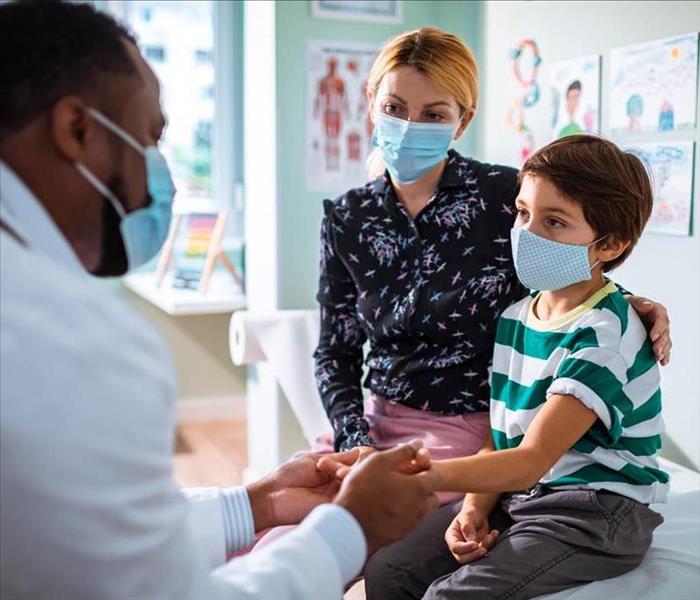Hazards to Your Children's Health in the Aftermath of a Flood
11/16/2021 (Permalink)
 Taking steps to clean up properly after a disaster can significantly impact the health of your children
Taking steps to clean up properly after a disaster can significantly impact the health of your children
The immediate potential impacts of flooding, including drowning, landslides, debris, and structural damage, can be dangerous for children and adults alike. You need to be careful when dealing with the aftermath of a flood. Contaminated water and mold growth are two health-related issues that are common after such a disaster.
Proper flood cleanup can limit some of the health issues posed by flooding, especially when it comes to mold. Moisture may remain in drywall or tile grout and allow mold to thrive. Once it takes hold, the mold will continue to grow until it gets removed.
Mold expands its reach by releasing spores, which travel through the air and create new colonies when they land on moist spots. These airborne spores can also cause an allergic reaction.
Being aware of the hidden dangers of flood damage and taking steps to clean up properly after a disaster can significantly impact the health of your children. Here is what you need to know.
Health Risks Associated With Flooding
Floods can lead to water damage, which can cause a mold infestation without proper cleanup.
A post-flood cleaning and disinfecting strategy are essential, but it is only part of the overall effort to keep your children safe in the aftermath of a flood. In addition to avoiding direct dangers from floodwaters, downed power lines, or hazardous debris, parents need to consider contaminated items and water and the increased threat of carbon monoxide poisoning.
Carbon Monoxide
Gas-powered generators are a source of power after a natural disaster. These tools provide necessary electricity, but they also release carbon monoxide. Generators inside or near an enclosed space can cause this dangerous gas to build up.
Carbon monoxide poisoning can cause fatigue, headache, dizziness, confusion, and vomiting. Breathing large amounts of the gas can be fatal.
You can install a carbon monoxide detector in your home to detect this unseen gas. Since carbon monoxide poisoning is possible anytime exhaust is present, this detector is a good safety tool to have in your home at all times.
Furthermore, after a flood, do not operate a portable generator inside. Consumer Reports suggests keeping the motor at least 20 feet away from your home to avoid any possible contamination.
Contaminated Water
Floodwaters can contain pathogens, so it is best to keep children away from standing water until it subsides. Also, a flood might contaminate your water source. This can make it unsafe to use tap water for drinking, washing, or bathing.
According to the EPA, children may experience severe gastrointestinal problems because their immune systems are not fully developed. In addition to immediate health issues, the long-term effects of exposure to contaminants can include developmental and neurological problems. In addition to illnesses caused by microbes like E. coli and Giardia, chemicals in contaminated water can cause health issues.
After a flood, give your children bottled water to drink. Any water you use for bathing or washing anything needs to be boiled or purified with iodine, chlorine, or a filter.
Contaminated Items
Floodwaters may also contaminate household items. Microbes can cling to surfaces on children's toys and kitchen utensils. The illness-causing substances could then transfer to your children when they use these items.
Thoroughly wash everything with soap and water and dry completely in the open air. Using a substance such as chlorine bleach during cleaning can kill bacteria and microbes contained in the floodwaters.
Unfortunately, you will probably need to throw away any wooden items or soft or absorbent toys. Any baby bottles or pacifiers should also be removed from the home because it is impossible to decontaminate these items.
How To Treat Mold in Your Home
After a flood, you need to start the water damage restoration process. This effort involves returning everything in the home to its pre-flood condition and removing any dangerous substances the waters brought into the house.
Mold remediation and removal are vital steps in this process because mold can cause health effects.
Here are some tips on how you can clean up molds from your house after a flood.
- Clean up standing water and remove all wet items from the house. The first step is to stop the buildup of moisture. If necessary, you should call in an expert to handle the job. You can also use equipment such as dehumidifiers to remove moisture from walls.
- Open up your home to fresh air. This step can help the drying process (especially if the outside humidity levels are low), and it may limit dangers from carbon monoxide or other airborne contaminants.
- Clean mold from hard surfaces. You can use natural solutions or detergents to clean mold from hard surfaces. You will need to pay special attention to corners and crevices during this process. Calling in a professional or using chemicals such as chlorine bleach may be necessary to ensure complete removal.
- Remove porous or absorbent materials. Carpeting, wood, and cloth that came into contact with floodwaters will need to be removed because of the danger of mold and contaminants. It is impossible to remove mold from porous surfaces.
- Get a professional inspection to ensure complete removal. Mold can grow in walls and corners and remain unseen for years. If you do not rely on a pro for removal and remediation, you can still enlist the help of an expert to ensure that you did everything correctly to limit the chances of mold growing in the future.
Removing the source of mold is essential, but you can also get a HEPA air filter for your HVAC or filtration system. This can remove most mold spores from the air.





 24/7 Emergency Service
24/7 Emergency Service